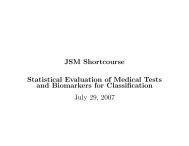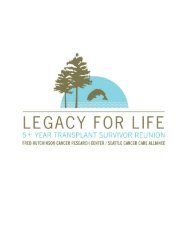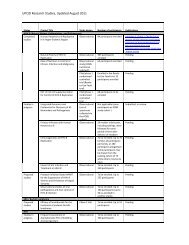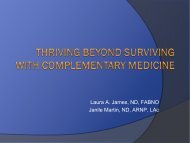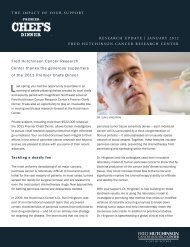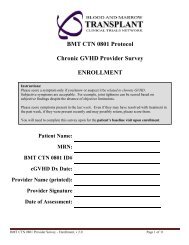Summer Undergraduate Research Program - Fred Hutchinson ...
Summer Undergraduate Research Program - Fred Hutchinson ...
Summer Undergraduate Research Program - Fred Hutchinson ...
You also want an ePaper? Increase the reach of your titles
YUMPU automatically turns print PDFs into web optimized ePapers that Google loves.
Alternative Functions of Telomerase in Breast Cancer<br />
Kelea Somerton, Shibani Mukherjee, Eduardo J. Firpo, James M. Roberts<br />
Proliferation advantage conferred by Telomerase<br />
is necessary and sufficient to cooperate with<br />
Her2 and form dysmorphic acini<br />
Abstract Methods<br />
HMECs were transduced with retroviral vectors containing either WT, NTERM, or NDAT forms<br />
of Telomerase, or empty vector. To examine the cooperation between Telomerase and Her2,<br />
structures were transduced with two separate vectors, one containing either WT, NDAT, or<br />
NTERM Telomerase or empty vector, and the other containing inducible Her2. Transduced<br />
cells were then grown in 3D culture on a Matrigel bed. After 10 days in culture, Her2 was<br />
induced by adding AP1510.<br />
2010 Lee Hartwell Poster Award<br />
**<br />
**<br />
**<br />
**<br />
Vec WT NTerm NDAT<br />
+Her2 +Her2 +Her2 +Her2<br />
4A. 4B. 4C.<br />
35<br />
70<br />
30<br />
**<br />
30<br />
60 **<br />
25<br />
25<br />
50<br />
**<br />
20<br />
20<br />
40<br />
**<br />
15<br />
15<br />
30<br />
10<br />
20<br />
10<br />
5<br />
10<br />
5<br />
0<br />
0<br />
0<br />
Vec WT Vec WT<br />
Vec WT NTerm NDAT<br />
+Her2 +Her2<br />
+Her2 +Her2 +Her2 +Her2<br />
4D.<br />
Average Luminal cells/ Acinus<br />
Average Cell numbers/ Acinus<br />
Average Cell numbers/ Acinus<br />
Cultures were fixed at either day 15 or 19. Day 15 structures were immunostained for Ki67<br />
(proliferation marker) and counter-stained for To-Pro-3 (DNA). Using confocal microscopy,<br />
images of the midsections of approximately 60 acinar structures (containing more than 7<br />
cells per midsection) for each cell type were collected. The total number of cells per acinar<br />
midsection, as well as the number of luminal and Ki67 positive cells were counted for each<br />
acinus. A t-test was used to analyze the results and p-values were determined.<br />
The Telomerase protein is upregulated in almost all human cancers. Telomerase can<br />
contribute to tumorigenesis by maintaining the telomeres cancer cells, thus enabling the cells<br />
to avoid senescence and have an extended lifespan. We have identified additional telomereindependent<br />
roles for Telomerase in tumorigenesis. We have seen that Telomerase can cause<br />
proliferation of primary human mammary epithelial cells (HMECs) in growth-factor-limiting<br />
conditions, which is a hallmark of cancer. Additionally, we have separated this proliferation<br />
advantage function of Telomerase from its telomere maintenance and extended lifespan<br />
functions with the use of two mutant forms of Telomerase, NTERM and NDAT. In this study,<br />
we extend these findings using a 3-Dimensional cell culture model system in which HMECs<br />
plated on Matrigel develop into 3D spheres of cells, called acini. The spheres resemble<br />
Terminal Ductal Lobular units in the breast, which have growth-arrested cells and hollow<br />
lumens. Hyperplasia and Ductal Carcinoma in situ (early stages of breast cancer) show<br />
increased proliferation of epithelial cells and filling of the lumen. We use the more<br />
physiologically relevant 3D culture system to model acini and study the aberrant phenotypes<br />
associated with breast cancer initiation and progression. We also use this system to analyze<br />
the ability of Telomerase to cooperate with the Her2 oncogene, which is upregulated in 20-<br />
30% of breast cancers. We show that the proliferation advantage conferred by Telomerase is<br />
sufficient to cause increased proliferation and luminal filling, resulting in acinar structures that<br />
share properties of early stage breast cancer. We further show that Telomerase is necessary<br />
for Her2-mediated proliferation and luminal filling. Their cooperation results in formation of<br />
dysmorphic acini, which retain an intact basement membrane and resemble early stage, preinvasive<br />
breast cancer. Finally, we show that the proliferation advantage function alone is<br />
sufficient for this cooperation with Her2.<br />
Vec+Her2 WT+Her2<br />
NTerm+Her2 NDAT+Her2<br />
Day 19 acinar structures were visualized using a Nikon SMZ1500 microscope. Structures<br />
were then immunostained for Laminin V (basement membrane marker) and counter-stained<br />
for To-Pro-3 (DNA), and imaged using confocal microscopy.<br />
4E.<br />
Background<br />
154<br />
Proliferation advantage conferred by Telomerase<br />
is sufficient to increase cell numbers and cause<br />
luminal filling of acini in 3D culture<br />
Figure 4. Determining effects of WT and mutant forms of Telomerase on the ability of<br />
Her2 to form dysmorphic acini.<br />
4A: Cells transduced with either WT Telomerase or Her2 alone were compared to cells with<br />
both WT Telomerase and Her2. Cells were stained with To-Pro-3. Average cell numbers per<br />
acinar midsection are shown. **p




